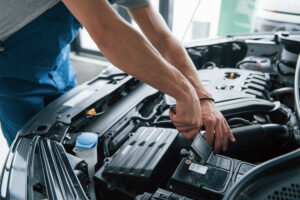Automotive batteries, essential for powering vehicles, fall under a unique hazard class due to their composition and potential risks. This article explores the classification of automotive batteries, an example of which hazard class, the risks associated with handling and disposal, and the importance of adhering to safety protocols. Understanding these aspects is crucial for anyone dealing with automotive batteries, whether professionally or as a vehicle owner.
Understanding the Hazard Class of Automotive Batteries
Automotive batteries are classified as hazardous materials due to their chemical composition. This classification is primarily because they contain sulfuric acid and lead, making them fall under Hazard Class 8: Corrosive Materials. Understanding the classifications of automotive batteries are an example of which hazard class helps recognize the potential risks and the need for careful handling.
Why Are Automotive Batteries Considered Hazardous?
The hazardous nature of automotive batteries stems from their corrosive materials. The sulfuric acid can cause severe burns to the skin or eyes and pose a risk to human health if ingested or inhaled. Additionally, lead is a toxic substance that can cause serious health problems. These factors make it imperative to handle automotive batteries with care.
The Risks Associated with Automotive Batteries
Handling automotive batteries involves risks such as chemical burns, environmental damage, and potential combustion. The corrosive nature of the electrolyte and the presence of lead plates require careful handling and adherence to safety protocols to prevent accidents and environmental contamination.

Automotive Batteries Are An Example of Hazardous Materials
Automotive batteries are a quintessential example of hazardous materials that require meticulous handling. Containing substances that can cause damage, such as corrosive acids and heavy metals, these batteries pose significant risks if not managed correctly. The corrosive nature of the electrolyte within can lead to severe chemical burns or environmental damage through corrosion. It’s crucial that these hazardous materials are correctly identified, handled, and stored to prevent accidents and ensure safety. This awareness is not just about adhering to regulations; it’s about recognizing the potential harm these materials can cause and taking proactive steps to mitigate risks.
The Imperative of Proper Disposal for Hazardous Materials
Disposing of hazardous materials, particularly automotive batteries, is a critical environmental concern. These batteries contain substances that can cause damage to living tissue and the environment if not disposed of properly. The disposal process must be carried out with utmost care to prevent leakage and contamination, which can lead to soil and water pollution. Recycling is often the most effective method, allowing for the safe extraction and reuse of valuable materials while minimizing environmental impact. Proper disposal is not just a legal obligation but a moral one, ensuring that we do not pass on the detrimental effects of our consumption to future generations.
Proper Handling and Disposal of Automotive Batteries
Proper handling and disposal of automotive batteries are essential to ensure safety and environmental protection. This includes wearing protective gear like safety goggles, handling batteries away from heat sources, and following local regulations for disposal. Recycling is a preferred method, as it helps in mitigating environmental impact.
The Two Main Battery Types and Their Hazards
Lead-acid batteries and lithium-ion batteries are the two main types used in vehicles. Each type encompasses hazardous materials, with lead-acid batteries, including sulfuric acid and lead, and lithium-ion batteries posing risks due to their flammable electrolyte.
Navigating EPA and DOT Regulations for Automotive Batteries
The Environmental Protection Agency (EPA) and the Department of Transportation (DOT) set regulations for handling and transporting hazardous materials, including automotive batteries. Adhering to these regulations, known as Hazardous Materials Regulations (HMR), is crucial for safety and compliance.
Miscellaneous Hazardous Material: Where Do Automotive Batteries Fit?
Automotive batteries also fall under the category of miscellaneous hazardous materials due to their potential risks during transportation. Ensuring that these batteries are correctly packaged and labeled according to HMR is vital for safe transport.
The Importance of Safety Protocols in Handling Automotive Batteries
Safety protocols for handling automotive batteries include using proper packaging, wearing protective equipment, and ensuring proper storage. These measures are essential to prevent accidents and protect both people and the environment from the harmful effects of these batteries.
How to Dispose of an Automotive Battery Safely
Disposing of an automotive battery requires following specific steps to prevent environmental harm. This includes taking the battery to a recycling center or a facility equipped to handle hazardous materials. Never dispose of automotive batteries in regular trash due to their toxic and corrosive nature.



